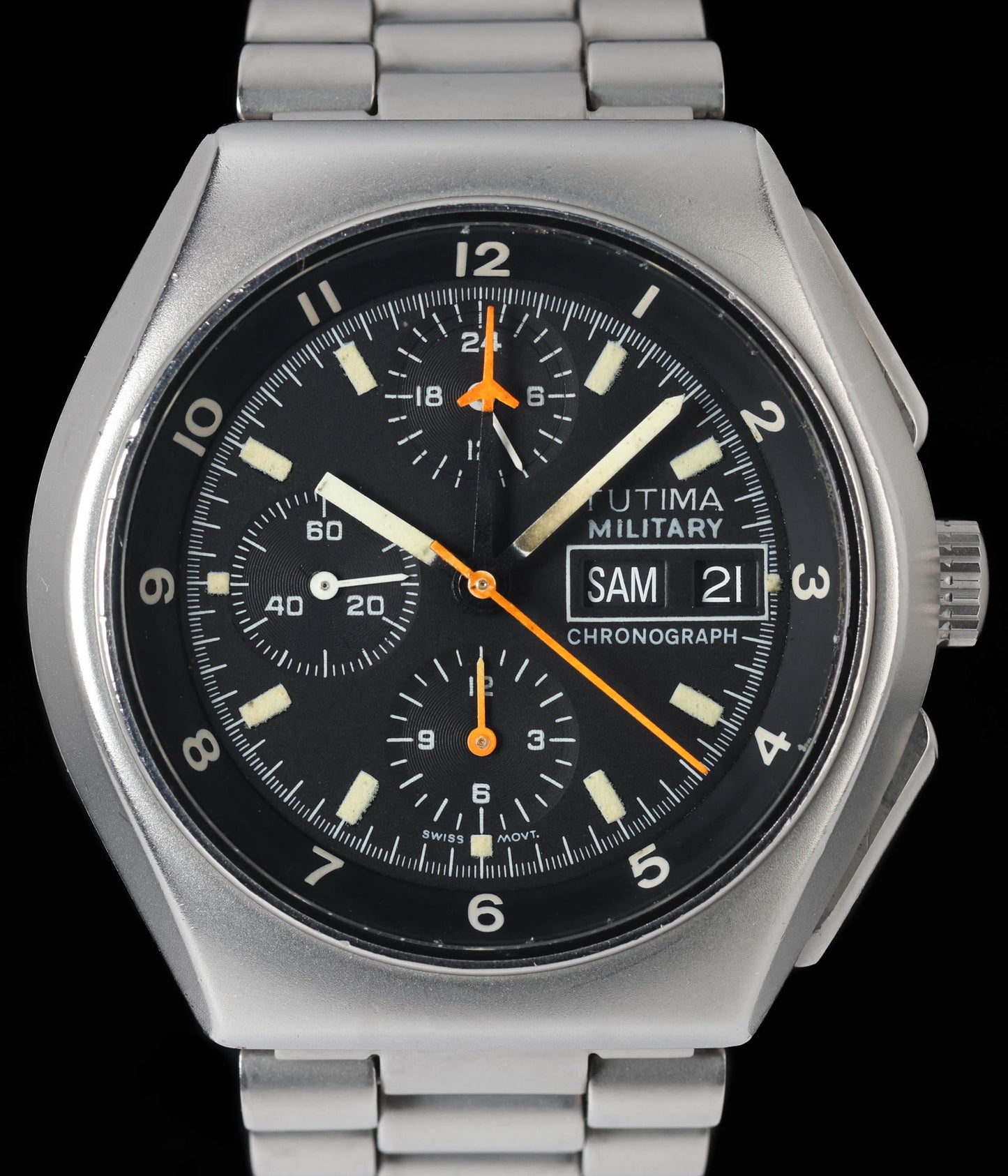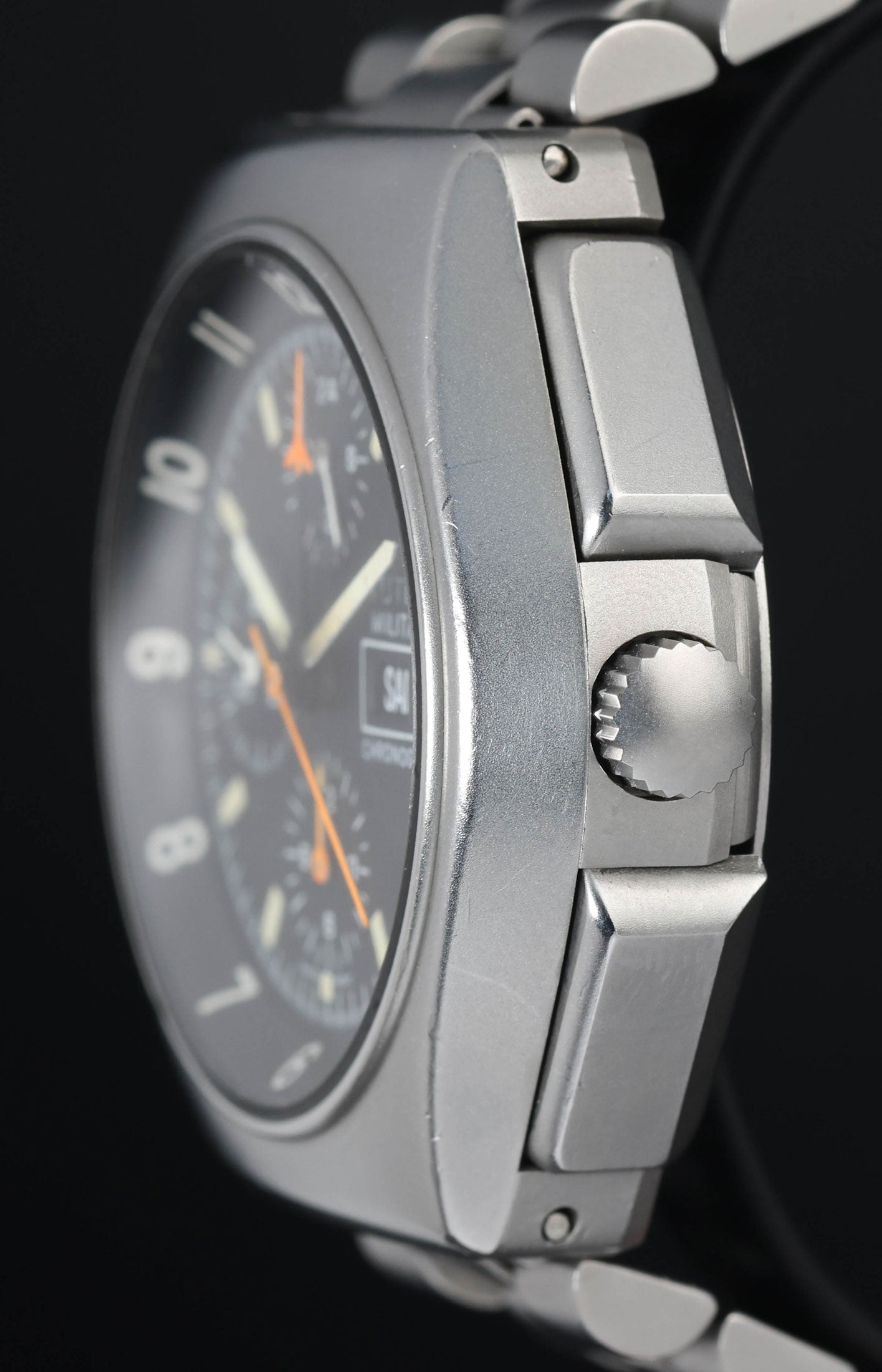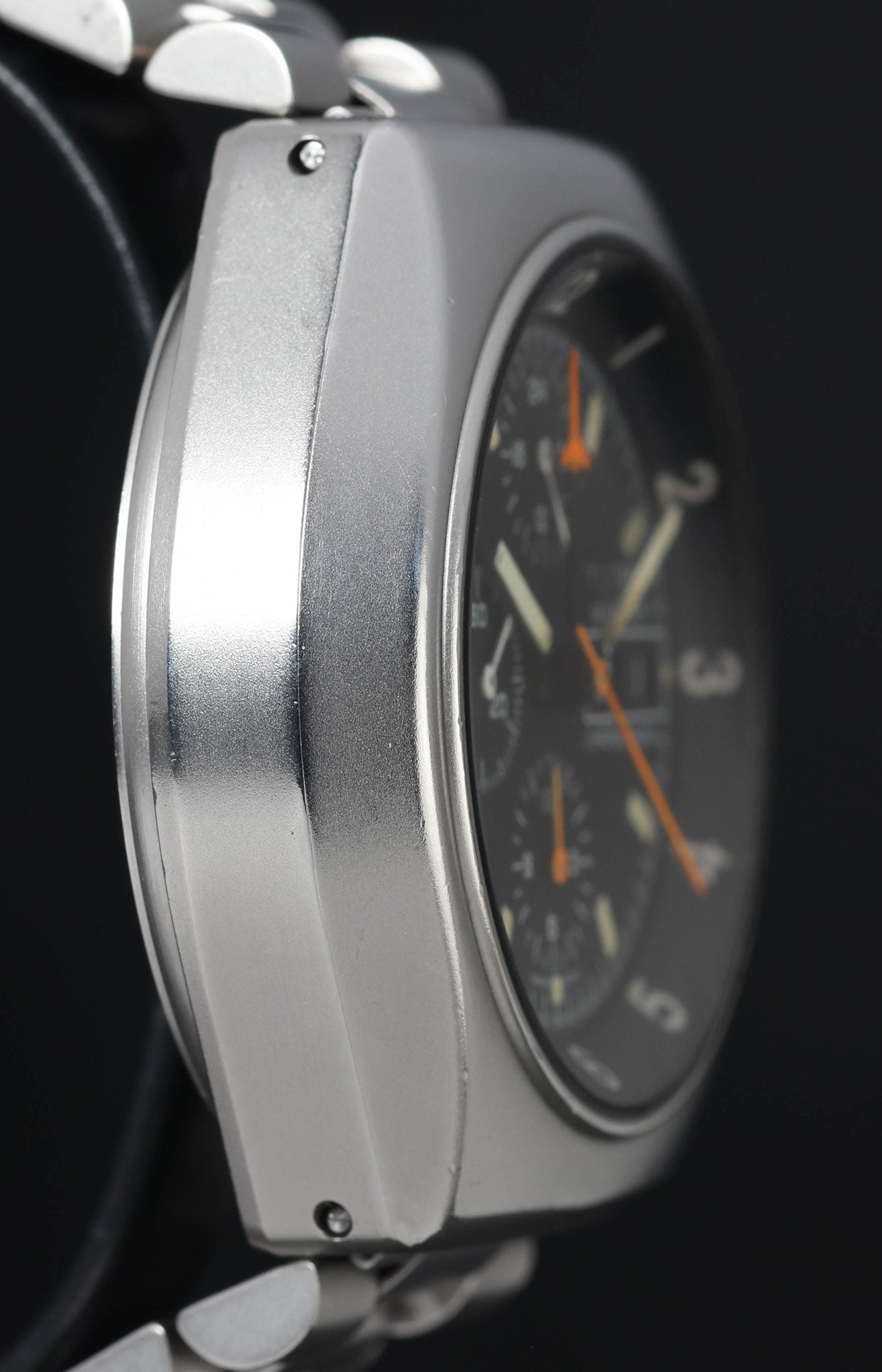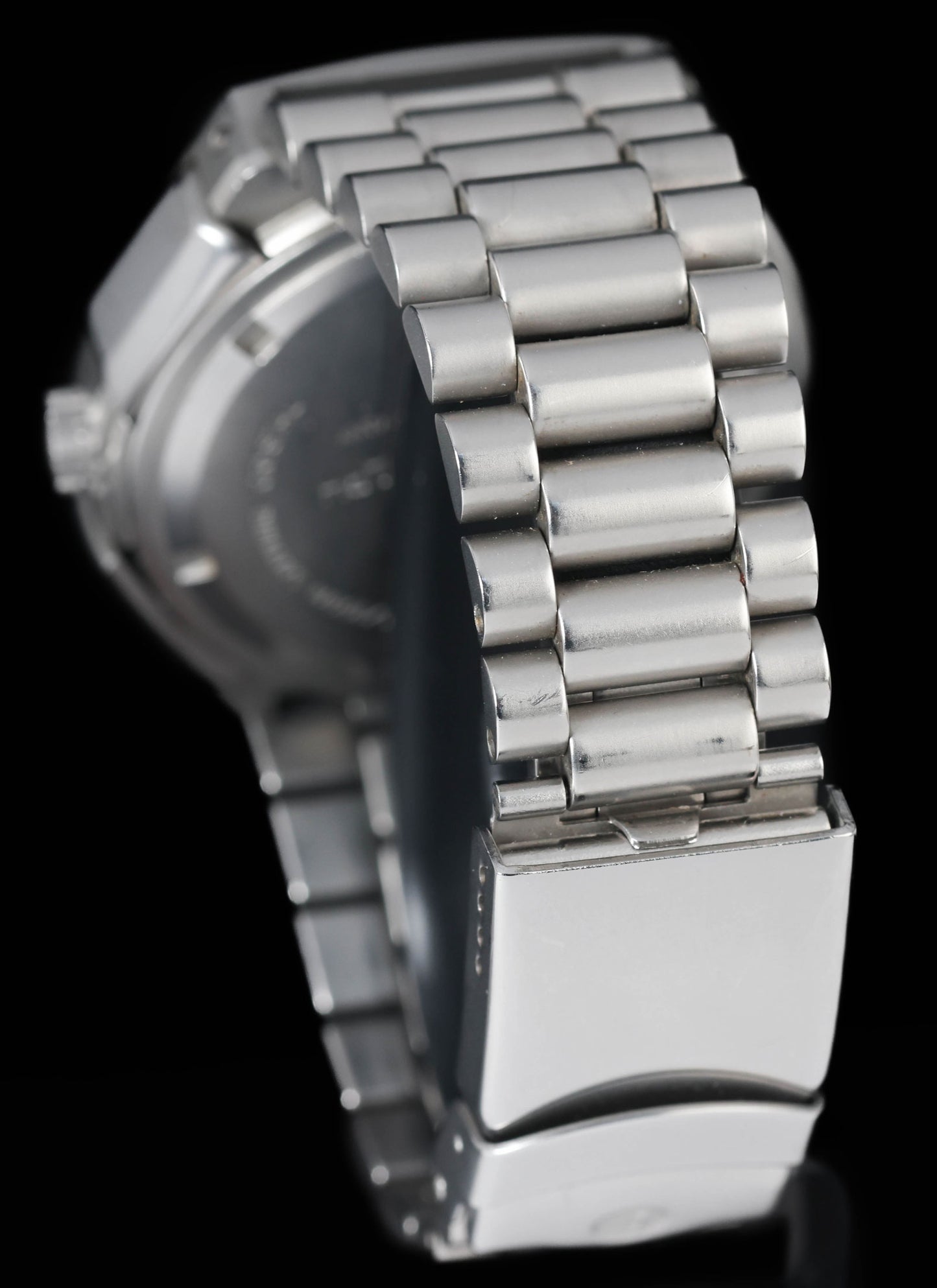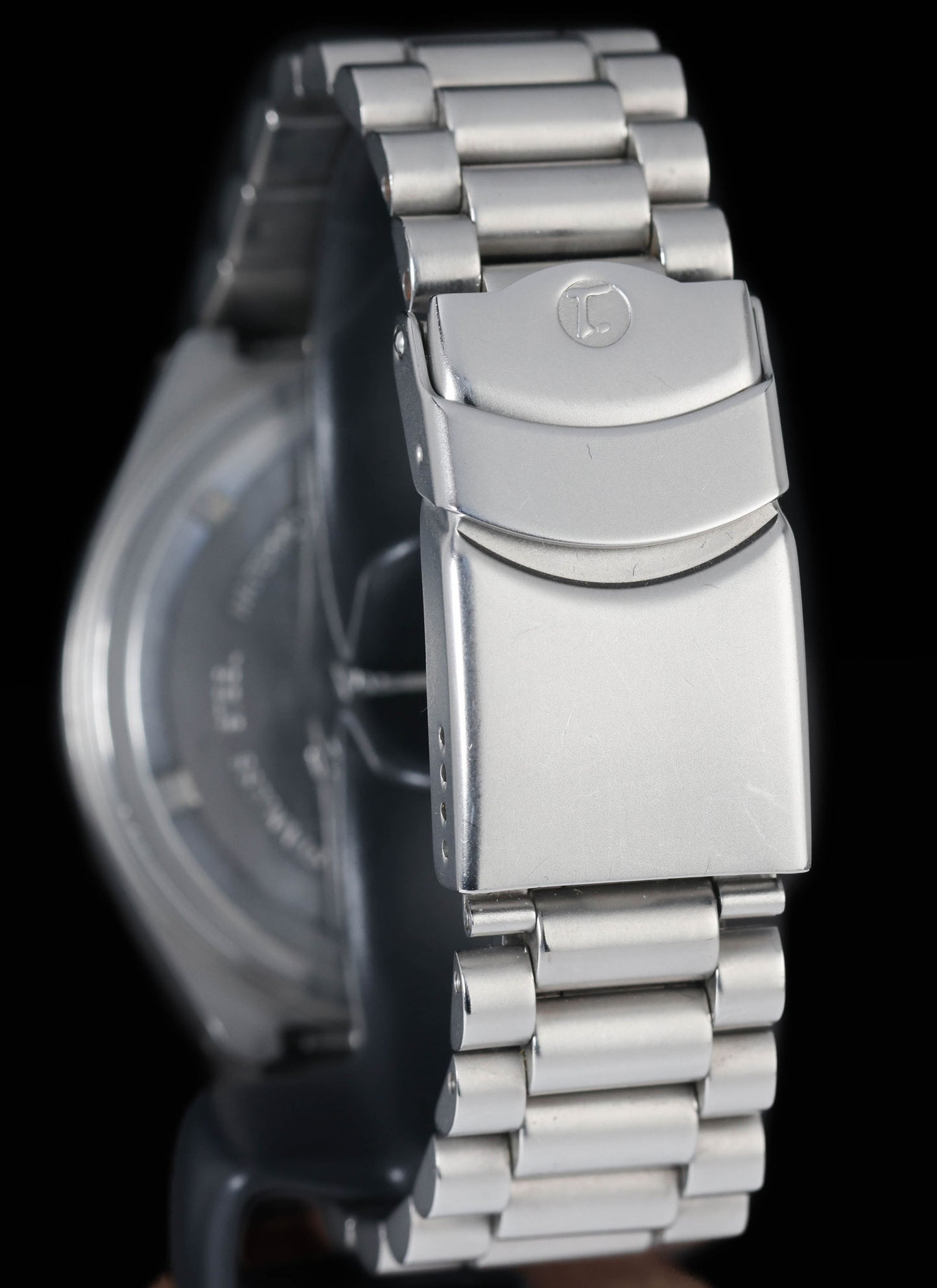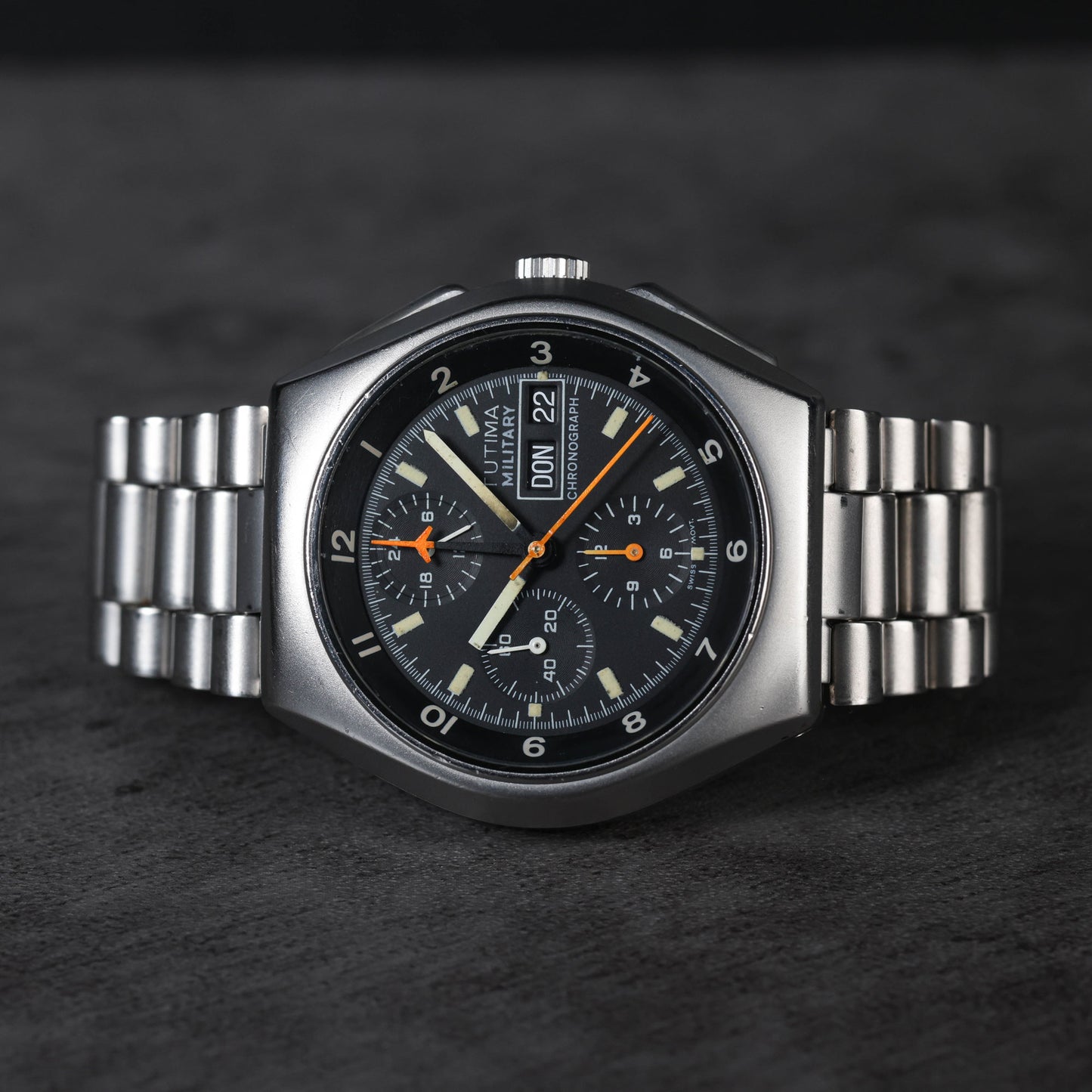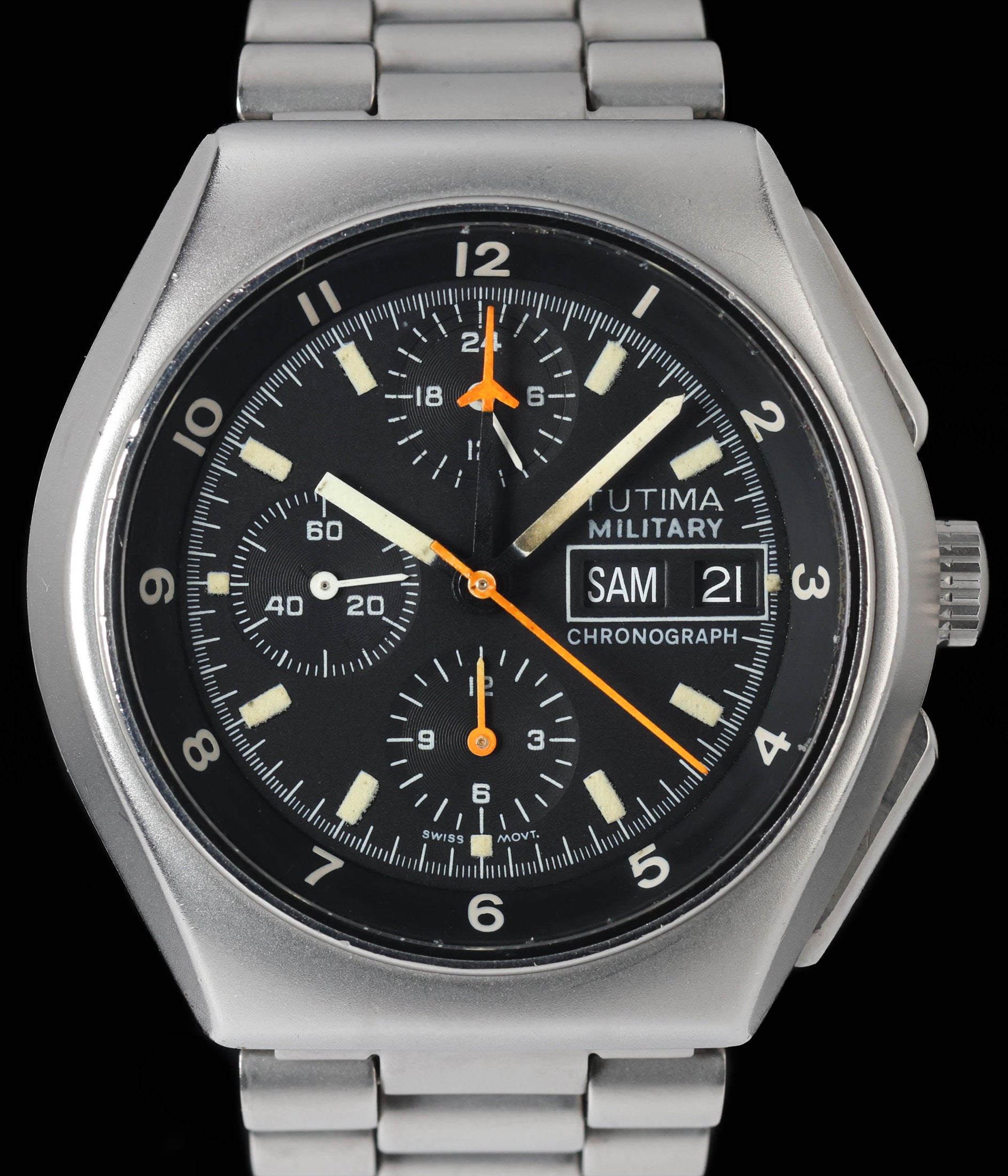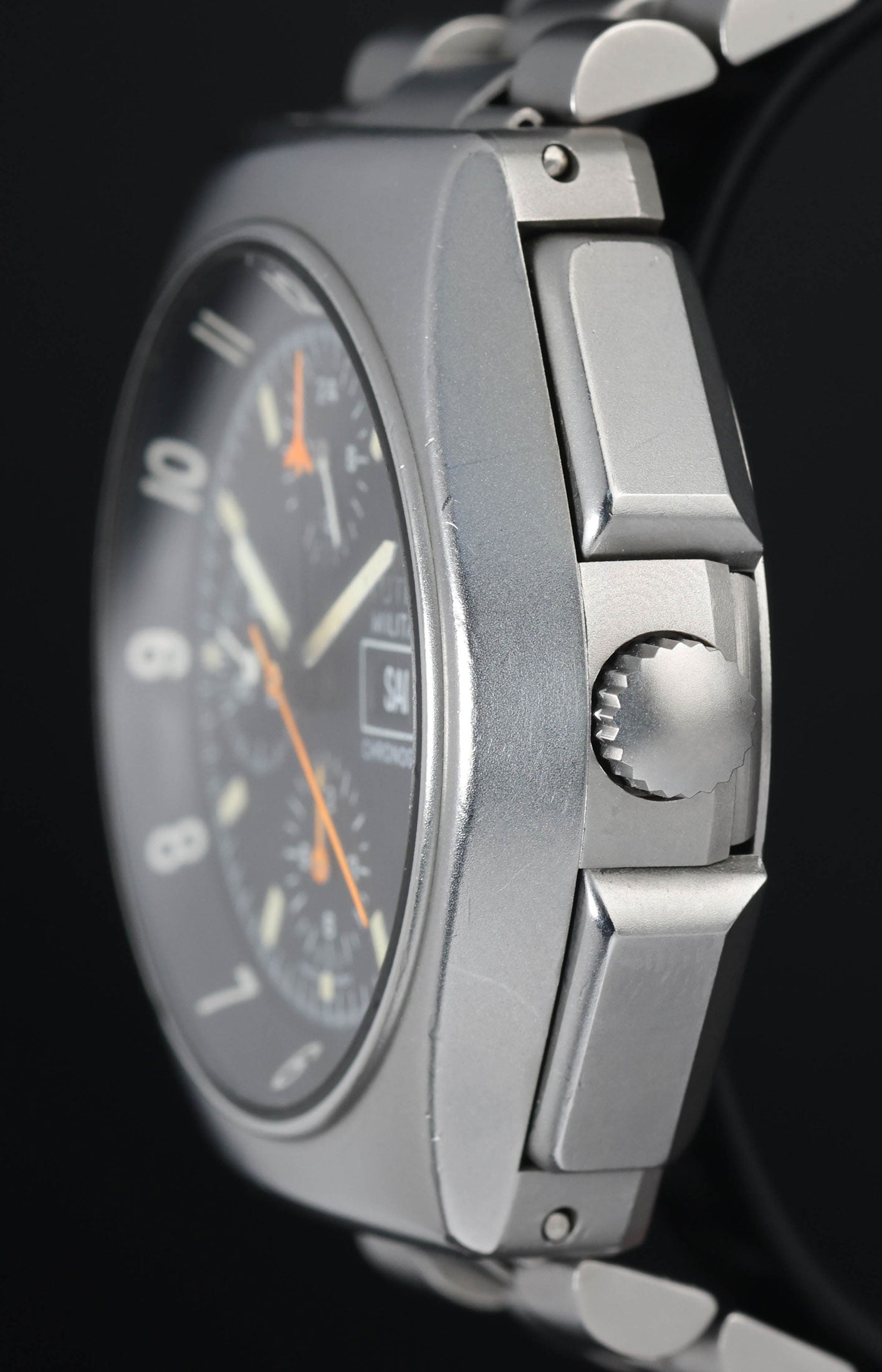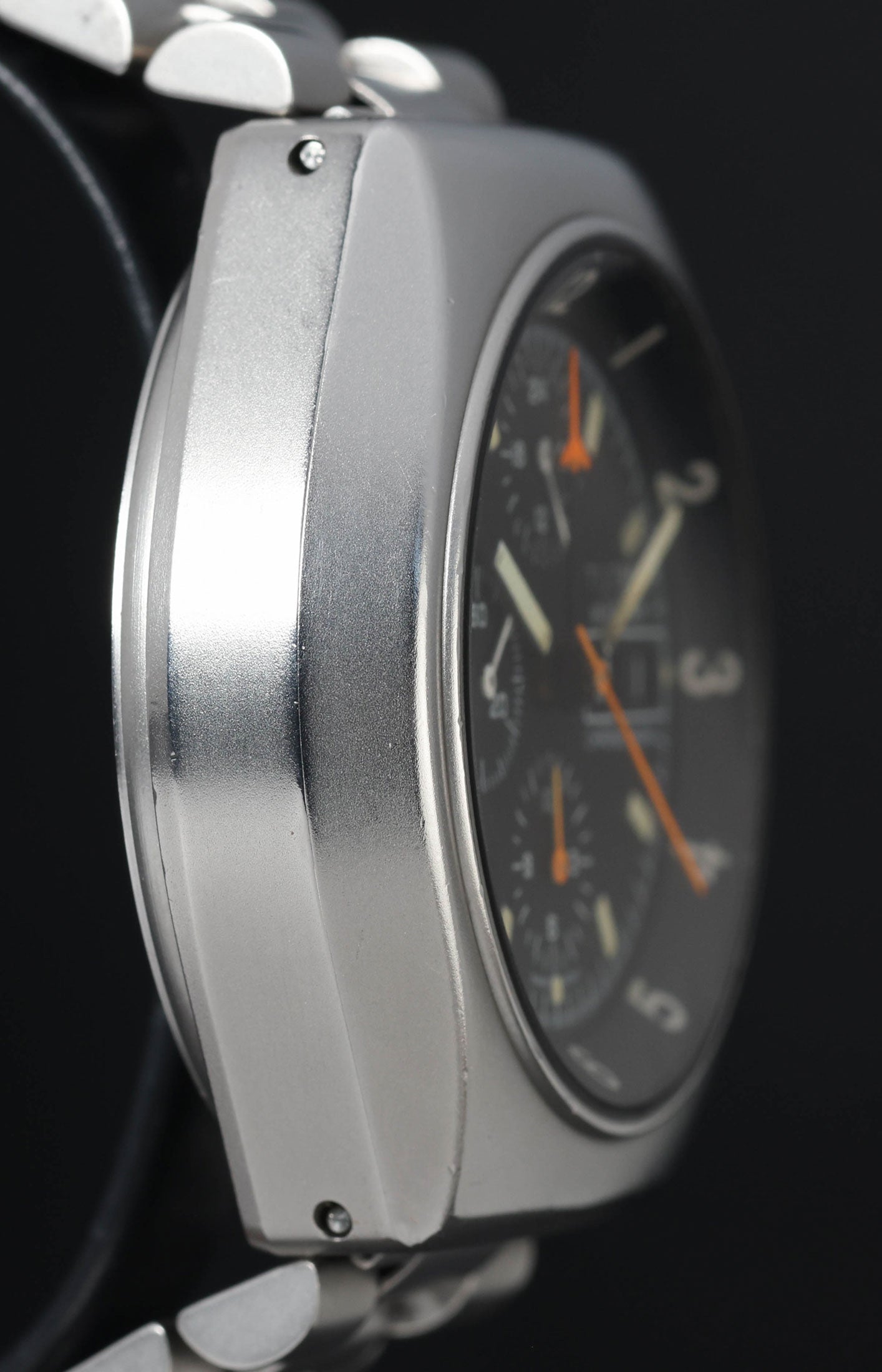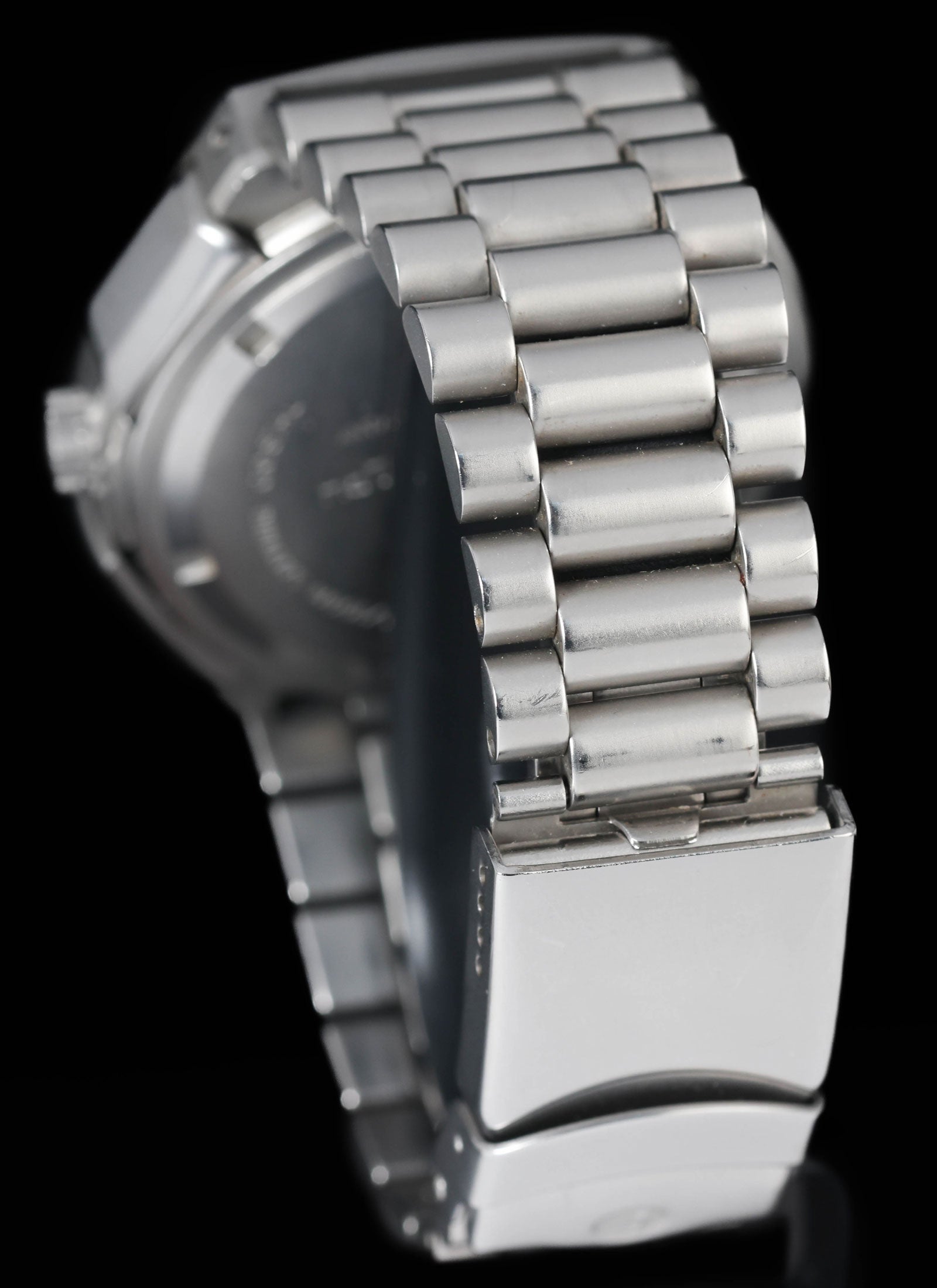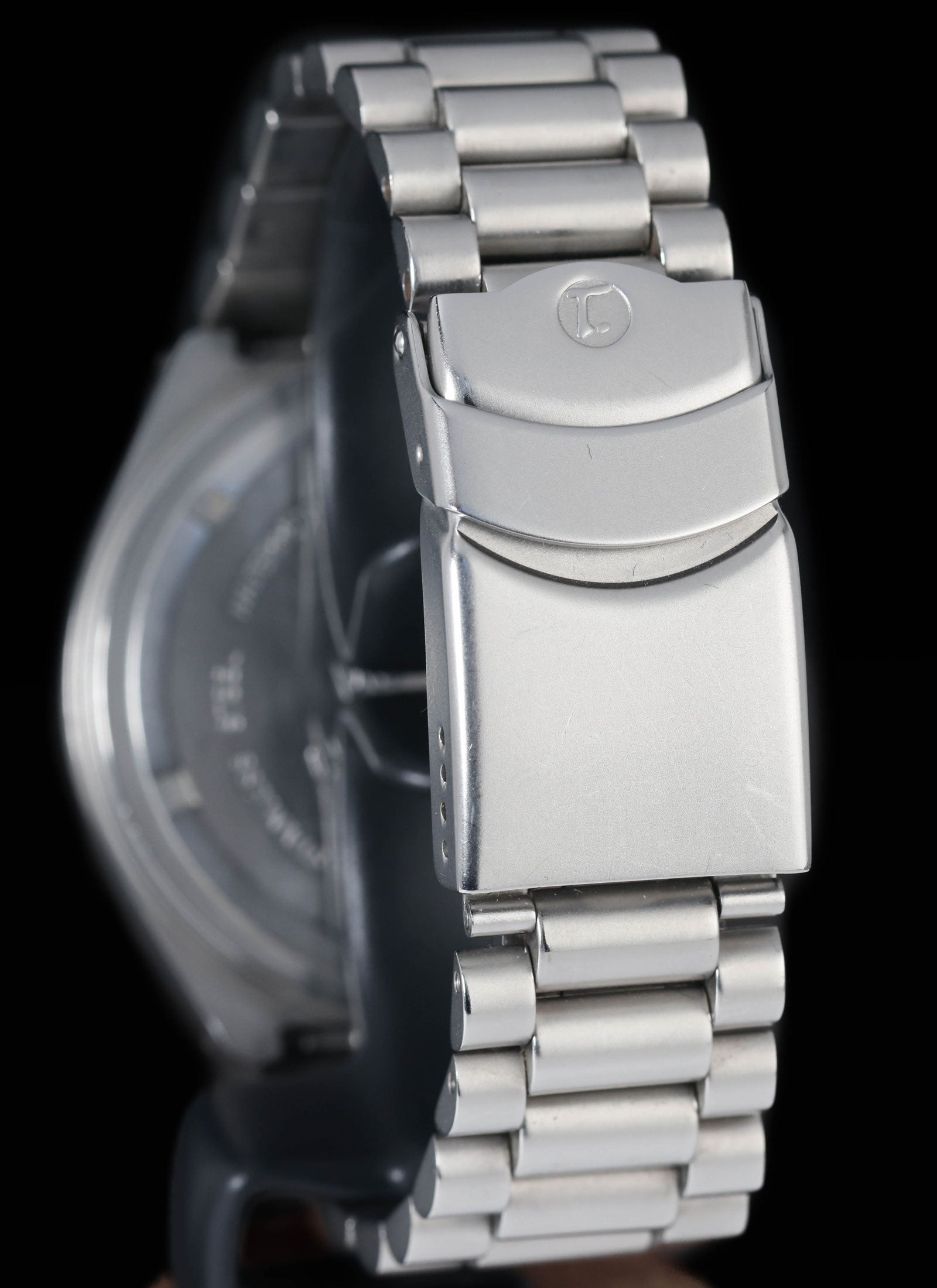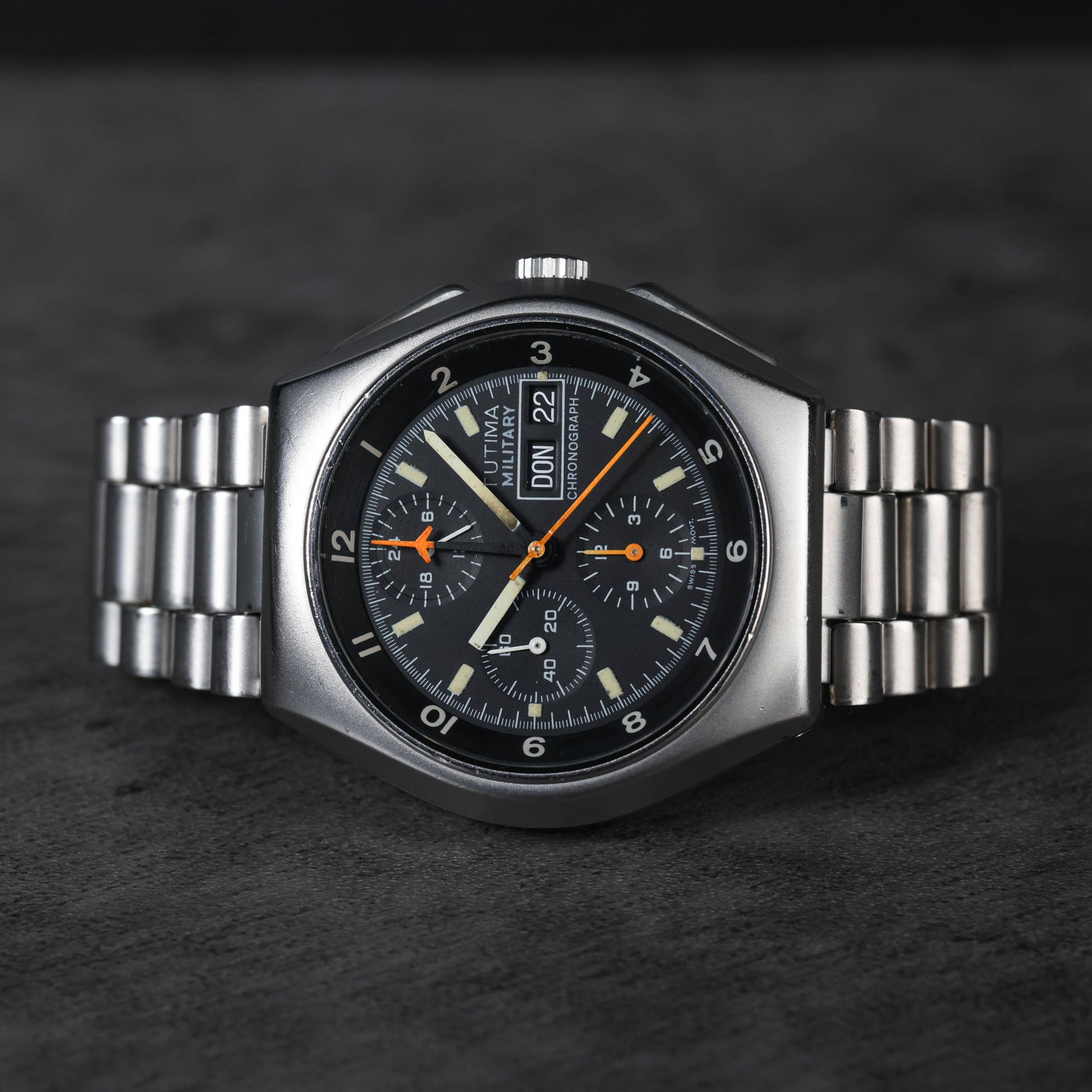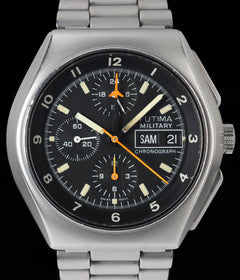Crown Vintage
Tutima Military Chronograph 'Fliegerchronograph' 798-002 43mm Circa 1980s
Tutima Military Chronograph 'Fliegerchronograph' 798-002 43mm Circa 1980s
Couldn't load pickup availability
Tutima Military Chronograph 'Fliegerchronograph'
This Tutima Military Chronograph 798-02 presents in excellent overall order for a mid- to late-1980s example. The bead-blasted stainless-steel case retains sharp hooded lugs and uniform matte finishing, with only the faintest marks from careful wear. Its case-back still bears the “W. Germany” stamp, confirming pre-1990 manufacture, yet the dial reads “Swiss Mvt”, indicating a factory-supplied service dial likely fitted between 1990 and 1997.
The matte black dial itself has aged gracefully, taking on a creamy patina that now matches the luminous syringe hands and central chronograph indicators. Printing remains crisp, sub-dial recesses are clean, and there is no evidence of moisture intrusion or relume. Hands show equally strong condition, with intact luminous material and no corrosion at hubs or tips.
The original solid-link bracelet and deployant clasp are in great condition; light hairlines on the outer links are consistent with gentle use, and all internals close securely without play. Pushers and crown operate smoothly, and crystal clarity is unimpeded by scratches or chips.
As with any 30-plus-year-old flight chronograph, water-resistance can no longer be guaranteed; the watch should be kept clear of immersion and pressure testing is advised before regular wear
Share
Why we love this watch
Why we love this watch
Tutima Military Chronograph 798-02: Cold War Fliegerchronograph Icon
Tutima’s Origins in Glashütte
The Tutima name traces back to 1927, when lawyer-entrepreneur Dr Ernst Kurtz reorganised the bankrupt Deutsche Präzisions-Uhrenfabrik into the movement maker UROFA and the completed-watch arm UFAG. “Tutima”—from the Latin tutus, meaning “safe” or “secure”—became UFAG’s premium quality label, stamped only on its most exacting timepieces. Operating in Germany’s watchmaking capital, Glashütte, the firm embraced precision chronometry from the outset, an emphasis that would later prove vital when pilots needed cockpit instruments they could trust.
Wartime Breakthrough: Fliegerchronograph 59
Tutima’s reputation among aviators began in 1941 with the Fliegerchronograph 59. This two-pusher, fly-back pilot’s watch featured oversized crowns and pushers, a central minute counter for instant readability and rugged shock protection—traits that set the design language for German flight watches. Luftwaffe crews prized its at-a-glance legibility, and the model’s performance under combat conditions defined the term “Fliegerchronograph” (aviator chronograph) in German horology.
Displacement and Rebirth in West Germany
Heavy bombing in 1945 destroyed much of Glashütte’s watch industry, and the advancing Soviet administration dismantled the remaining machinery. Kurtz fled west, taking his expertise but little else. Through the 1950s and 1960s Tutima survived by assembling small-batch chronographs for niche clients and servicing wartime pieces still in military reserve. The modest output nevertheless preserved the Fliegerchronograph know-how that would become essential once NATO procurement officers searched for a modern, jet-age chronograph.
Cold-War Procurement and the Need for a New Pilot Chronograph
By the late 1970s the West German Luftwaffe wanted an automatic chronograph robust enough for high-g manoeuvres, pressurised cockpits and extreme temperature swings. Requirements included flawless running after 7 g catapult launches, resistance to sudden cabin depressurisation, water resistance beyond 100 metres and a dial that allowed calculation of elapsed minutes without cross-referencing sub-dials or slide rules. Tutima’s legacy within German military aviation and its experience building shock-proof chronographs put the company on the short list when the Bundeswehr issued a formal tender in the early 1980s. Competitors such as Sinn and Heuer also submitted prototypes, but Tutima’s proposal—internally coded reference 798—answered every demand while maintaining field-service simplicity.
The 798 Programme: Designing a NATO-Grade Instrument
Tutima engineers began with a 43 millimetre two-piece stainless-steel case, bead-blasted to eliminate reflections in low-light cockpits. A screw-down crown at 3 o’clock and recessed pump pushers ensured protection against accidental engagement by gloves or flight-suit sleeves, while an internal gasket system and screw-locked back delivered a 200-metre water-resistance rating—far exceeding the tender’s 60-metre requirement. Final prototypes endured thermal cycling from −20 °C to +50 °C, magnetic fields of 80,000 A/m and rapid decompression equivalent to 16,000 metres without losing accuracy or fogging. In 1984 the watch won the contract, receiving the NATO Stock Number 6645-12-194-8642 and earning the nickname “NATO Chronograph”. The suffix “-02” identifies the stainless-steel bracelet variant, whereas “-12” was paired with a Kevlar strap for lighter weight.
Anatomy of the 798-02: Case, Dial and Bracelet
Every millimetre of the 798-02 serves a mission brief. The 14.5 millimetre thickness sits low enough beneath flight-glove cuffs, and short, hooded lugs prevent snagging on harness straps. Tutima’s solid-link steel bracelet integrates a ratcheting extension, allowing pilots to secure the watch over bulky G-suits or to cinch it tight against bare wrists once airborne. The dial is pure instrument panel: matte black, anti-reflective and uncluttered. Syringe-style hands filled with luminous compound contrast against oversize Arabic numerals. At centre, a yellow-tipped minute hand and a white chronograph seconds hand sweep together, eliminating the need to read a small counter under stress. Sub-dials at 12, 6 and 9 display 24-hour time, 12-hour totals and running seconds respectively, while day–date apertures sit at 3, available in English or German to suit NATO operators.
Lemania 5100: Engineered for Combat Aviation
Powering the 798-02 is the Lemania 5100, an integrated automatic chronograph calibre built expressly for military use. Introduced in 1974, it runs at 28,800 vph, stores roughly 48 hours of autonomy and features a cam switching system proven more resistant to wear under shock than delicate column-wheel designs. Plastic shock absorbers and nylon chronograph gears enable the movement to shrug off violent G-forces that once shredded traditional chronographs. Crucially, the calibre’s architecture places both elapsed seconds and elapsed minutes on central axes, allowing instant elapsed-time reference during fuel checks, bombing runs or IFR holds. The Bundeswehr valued this readability so highly that it wrote the central-minutes clause directly into its procurement specification, virtually guaranteeing the Lemania 5100 a long career inside German military chronographs. Production of the movement ceased in 2002, further cementing the 798-02’s historical significance.
Life in the Cockpit: Military Service and NATO Adoption
Following the 1984 contract award, Tutima delivered thousands of 798-02 watches to the Luftwaffe and other NATO air arms. Tornado IDS and F-4F Phantom crews appreciated the watch’s glove-friendly crown and bezel-like 60-minute scale created by the central hand. Artillery observers, naval helicopter pilots and even USAF evaluators placed small supplementary orders, and service reports repeatedly highlighted the chronograph’s ability to retain amplitude after ejection-seat qualification blasts. Because each watch carried the same NSN, multinational NATO logistics channels could supply parts quickly, ensuring operational readiness from Norway to the Gulf. The term “Bund” grew in enthusiast circles to denote any German-issued example, a nod to the Bundeswehr property records stamped on their case backs.
Fliegerchronograph: Defining the Term and the 798-02’s Place in the Lineage
“Fliegerchronograph” literally translates as “aviator chronograph” and refers to timepieces built to exacting flight-deck standards: robust case construction, fly-back or quick-reset capability, superior shock protection and legibility in any lighting. Tutima coined the term informally with its 1941 model, but the Bundeswehr tender of the 1980s effectively codified its technical parameters. The 798-02 fulfils every principle of the Fliegerchronograph tradition: oversized hands for instant reading, a dial uncluttered by decorative elements, pushers that remain operable in pressurised gloves and a movement resistant to acceleration well beyond civil-aviation limits. Its adoption by NATO further internationalised the term, leading many collectors to view the 798-02 as the definitive Cold-War Fliegerchronograph—an instrument born of earlier Luftwaffe designs yet optimised for jet fighters and alliance interoperability.
Continuing Influence and Modern Recognition
Tutima’s present-day M2 series borrows the original case geometry, central-minutes display and sand-blasted finish, but renders them in titanium and pairs them with modern Sellita movements. These contemporary releases keep the 798-02’s DNA alive and introduce new audiences to the German Fliegerchronograph concept. Beyond the factory catalogue, the watch’s design language can be seen in cockpit-ready chronographs from other brands that now employ central-minutes modules to replicate the instant readability Tutima standardised. Military aviation museums, including those in Gatow and Berlin, display Luftwaffe flight gear complete with a 798-02 strapped to pressure gloves, underscoring the watch’s role as standard kit during the final decades of the Cold War.
Final Thoughts
The Tutima Military Chronograph 798-02 unites Glashütte craft, Cold-War engineering and NATO operational rigour in a single, purpose-built tool watch. Its sand-blasted steel shell withstands punishing environments, while the Lemania 5100 within provides the central-minutes functionality pilots demanded for fuel checks and timing attack runs. By fulfilling and exceeding the Bundeswehr’s stringent Fliegerchronograph specification, the 798-02 safeguarded Tutima’s wartime heritage and carried it into the jet age. Nearly forty years after its debut, the watch remains a benchmark for military aviation chronographs and an enduring symbol of German technical resilience. Its influence lives on in both modern Tutima releases and the design briefs of contemporary pilot watches worldwide, ensuring that the spirit of the original Fliegerchronograph beats on in every mission-ready wrist instrument. For further reading, refer to this excellent article at SJX https://watchesbysjx.com/2022/09/tutima-military-chronograph-798.html
Case & Bracelet
Case & Bracelet
Case in excellent condition, very minimal wear visible. Bracelet in great condition, light hairlines visible but remains in great shape for its age.
Dial & Hands
Dial & Hands
- Dial & hands in great condition, the matte dial has developed a lovely cream patina to match the hands.
- Dial & hands in great condition.
Warranty & Condition
Warranty & Condition
Crown Vintage Watches provides a minimum 3-month mechanical warranty on pre-owned watches, from the date of purchase.
The warranty covers mechanical defects only.
The warranty does not cover damages such as scratches, finish, crystals, glass, straps (leather, fabric or rubber damage due to wear and tear), damage resulting from wear under conditions exceeding the watch manufacturer’s water resistance limitations, and damage due to physical and or accidental abuse.
Please note, water resistance is neither tested nor guaranteed.
Shipping and insurance costs for warranty returns to us must be covered by the customer. Returns must be shipped via traceable courier. Return shipment must be pre-paid and fully insured. Collect shipping will be refused. In case of loss or damages, the customer is liable.
Our Pledge
At Crown Vintage Watches, we stand by the authenticity of every product we sell. For added peace of mind, customers are welcome to have items independently authenticated at their own expense.
Condition
Due to the nature of vintage timepieces, all watches are sold as is. We will accurately describe the current condition and working order of all watches we sell to the best of our ability.
Shipping & Refund
Shipping & Refund
